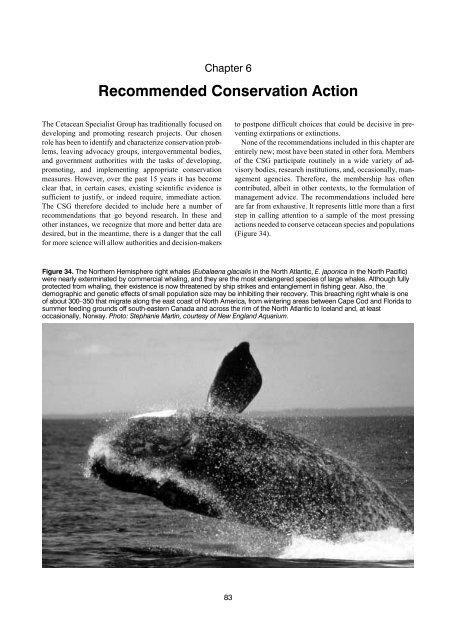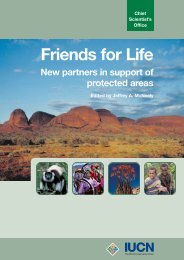Dolphins, Whales and Porpoises: 2002-2010 Conservation - IUCN
Dolphins, Whales and Porpoises: 2002-2010 Conservation - IUCN
Dolphins, Whales and Porpoises: 2002-2010 Conservation - IUCN
You also want an ePaper? Increase the reach of your titles
YUMPU automatically turns print PDFs into web optimized ePapers that Google loves.
Chapter 6<br />
Recommended <strong>Conservation</strong> Action<br />
The Cetacean Specialist Group has traditionally focused on<br />
developing <strong>and</strong> promoting research projects. Our chosen<br />
role has been to identify <strong>and</strong> characterize conservation problems,<br />
leaving advocacy groups, intergovernmental bodies,<br />
<strong>and</strong> government authorities with the tasks of developing,<br />
promoting, <strong>and</strong> implementing appropriate conservation<br />
measures. However, over the past 15 years it has become<br />
clear that, in certain cases, existing scientific evidence is<br />
sufficient to justify, or indeed require, immediate action.<br />
The CSG therefore decided to include here a number of<br />
recommendations that go beyond research. In these <strong>and</strong><br />
other instances, we recognize that more <strong>and</strong> better data are<br />
desired, but in the meantime, there is a danger that the call<br />
for more science will allow authorities <strong>and</strong> decision-makers<br />
83<br />
to postpone difficult choices that could be decisive in preventing<br />
extirpations or extinctions.<br />
None of the recommendations included in this chapter are<br />
entirely new; most have been stated in other fora. Members<br />
of the CSG participate routinely in a wide variety of advisory<br />
bodies, research institutions, <strong>and</strong>, occasionally, management<br />
agencies. Therefore, the membership has often<br />
contributed, albeit in other contexts, to the formulation of<br />
management advice. The recommendations included here<br />
are far from exhaustive. It represents little more than a first<br />
step in calling attention to a sample of the most pressing<br />
actions needed to conserve cetacean species <strong>and</strong> populations<br />
(Figure 34).<br />
Figure 34. The Northern Hemisphere right whales (Eubalaena glacialis in the North Atlantic, E. japonica in the North Pacific)<br />
were nearly exterminated by commercial whaling, <strong>and</strong> they are the most endangered species of large whales. Although fully<br />
protected from whaling, their existence is now threatened by ship strikes <strong>and</strong> entanglement in fishing gear. Also, the<br />
demographic <strong>and</strong> genetic effects of small population size may be inhibiting their recovery. This breaching right whale is one<br />
of about 300–350 that migrate along the east coast of North America, from wintering areas between Cape Cod <strong>and</strong> Florida to<br />
summer feeding grounds off south-eastern Canada <strong>and</strong> across the rim of the North Atlantic to Icel<strong>and</strong> <strong>and</strong>, at least<br />
occasionally, Norway. Photo: Stephanie Martin, courtesy of New Engl<strong>and</strong> Aquarium.






